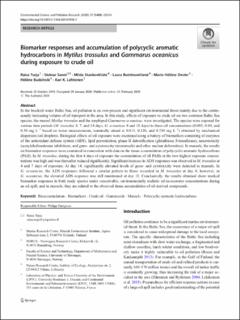| dc.description.abstract | In the brackish water Baltic Sea, oil pollution is an ever-present and significant environmental threat mainly due to the continuously increasing volume of oil transport in the area. In this study, effects of exposure to crude oil on two common Baltic Sea species, the mussel Mytilus trossulus and the amphipod Gammarus oceanicus, were investigated. The species were exposed for various time periods (M. trossulus 4, 7, and 14 days, G. oceanicus 4 and 11 days) to three oil concentrations (0.003, 0.04, and 0.30 mg L−1 based on water measurements, nominally aimed at 0.015, 0.120, and 0.750 mg L−1) obtained by mechanical dispersion (oil droplets). Biological effects of oil exposure were examined using a battery of biomarkers consisting of enzymes of the antioxidant defense system (ADS), lipid peroxidation, phase II detoxification (glutathione S-transferase), neurotoxicity (acetylcholinesterase inhibition), and geno- and cytotoxicity (micronuclei and other nuclear deformities). In mussels, the results on biomarker responses were examined in connection with data on the tissue accumulation of polycyclic aromatic hydrocarbons (PAH). In M. trossulus, during the first 4 days of exposure the accumulation of all PAHs in the two highest exposure concentrations was high and was thereafter reduced significantly. Significant increase in ADS responses was observed in M. trossulus at 4 and 7 days of exposure. At day 14, significantly elevated levels of geno- and cytotoxicity were detected in mussels. In G. oceanicus, the ADS responses followed a similar pattern to those recorded in M. trossulus at day 4; however, in G. oceanicus, the elevated ADS response was still maintained at day 11. Conclusively, the results obtained show marked biomarker responses in both study species under conceivable, environmentally realistic oil-in-seawater concentrations during an oil spill, and in mussels, they are related to the observed tissue accumulation of oil-derived compounds. | |

